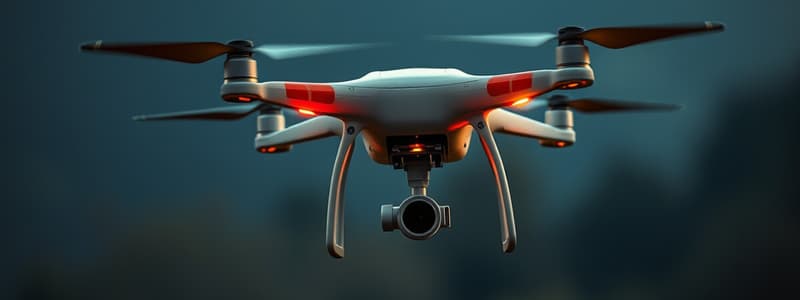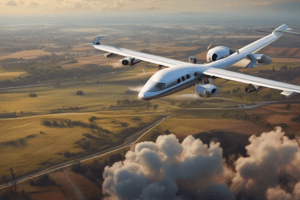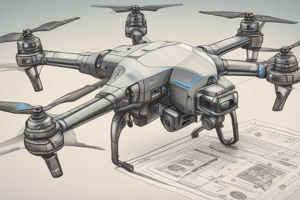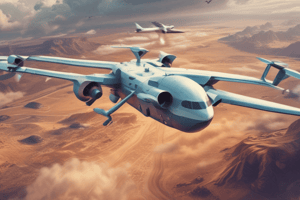Podcast
Questions and Answers
The recommended altitude for flying over buildings that are up to three stories is 150 ft AGL.
The recommended altitude for flying over buildings that are up to three stories is 150 ft AGL.
True (A)
It is acceptable to fly over moving vehicles while operating a drone.
It is acceptable to fly over moving vehicles while operating a drone.
False (B)
Maps created during drone flights are geo-referenced and align accurately with mapping software.
Maps created during drone flights are geo-referenced and align accurately with mapping software.
False (B)
Conducting a compass calibration is an important step for accurate navigation before a drone flight.
Conducting a compass calibration is an important step for accurate navigation before a drone flight.
Using cones and tape effectively prevents people from entering the designated takeoff and landing zone.
Using cones and tape effectively prevents people from entering the designated takeoff and landing zone.
What should you do before flying a drone to ensure safety regarding obstacles?
What should you do before flying a drone to ensure safety regarding obstacles?
What is the recommended flying altitude for a drone over buildings that are taller than five stories?
What is the recommended flying altitude for a drone over buildings that are taller than five stories?
Which component is essential for ensuring accurate navigation before a drone flight?
Which component is essential for ensuring accurate navigation before a drone flight?
What should be checked to avoid flying below necessary safety measures?
What should be checked to avoid flying below necessary safety measures?
What is a crucial step to take for flight preparation to help conserve battery life?
What is a crucial step to take for flight preparation to help conserve battery life?
Flashcards are hidden until you start studying
Study Notes
Drone Flight Preparation and Safety Measures
- Survey the area for obstacles such as busy roads and power lines before flying.
- Maintain a visual line of sight with the drone and avoid flying over people and moving vehicles.
- For buildings up to three stories, fly at 150 ft AGL; for buildings over five stories, consider flying at 200 ft AGL.
- Designate a clear area for drone takeoff and landing using cones and tape, though these may not fully deter people from entering the area.
Mapping and Model Considerations
- Maps created during flights are not geo-referenced, which may cause alignment issues with mapping software (e.g., Global Mapper, ArcGIS, QGIS).
- Use data points or ground control points (GCPs) for absolute positioning if data is sold to contractors.
Setting Up for the Flight
- Prepare the drone and mission prior to turning on the drone to conserve battery life.
- Check MOCA (Minimum Obstacle Clearance Altitude) before the flight by identifying the tallest obstacle in the area.
- Ensure the drone flies at least 10 ft above the MOCA to avoid obstacles.
Pre-flight Checklist
- Set the return-to-home altitude and check that obstacle avoidance is turned off.
- Conduct compass calibration for accurate navigation.
- Confirm automated flight settings (e.g., mapping elevations and file index mode) are appropriately configured.
Flight Execution
- Stabilize the drone before beginning the mission.
- Utilize the DJI app to set the gimbal pitch and start the mission operation after all setup steps are completed.
- Develop habits and routines for efficiency in conducting drone missions over time.
Drone Flight Preparation and Safety Measures
- Prior to flight, assess the environment for hazards like busy roads and power lines.
- Keep the drone within visual line of sight; avoid flying over crowds and moving vehicles.
- Recommended flight altitude: 150 ft AGL for buildings up to three stories; consider 200 ft AGL for structures over five stories.
- Clearly designate takeoff and landing zones with cones and tape, aware that these may not completely prevent unauthorized access.
Mapping and Model Considerations
- Maps generated during drone flights lack geo-referencing, potentially leading to alignment issues with mapping software like Global Mapper, ArcGIS, and QGIS.
- For accurate positioning in commercial applications, utilize data points or ground control points (GCPs).
Setting Up for the Flight
- Complete mission preparation and drone checks before powering up to conserve battery life.
- Verify the Minimum Obstacle Clearance Altitude (MOCA) by identifying the tallest nearby obstacle.
- Ensure the drone operates at least 10 ft above MOCA to maintain a safe distance from obstacles.
Pre-flight Checklist
- Set a return-to-home altitude and disable obstacle avoidance features as needed.
- Perform compass calibration to ensure precise navigation.
- Verify automated flight settings, including mapping elevations and file index mode configurations.
Flight Execution
- Achieve stable flight before commencing the mission.
- Use the DJI app to adjust gimbal pitch and initiate the mission only after all preparations are completed.
- Cultivate consistent habits and routines to enhance efficiency in future drone operations.
Drone Flight Preparation and Safety Measures
- Prior to flight, assess the environment for hazards like busy roads and power lines.
- Keep the drone within visual line of sight; avoid flying over crowds and moving vehicles.
- Recommended flight altitude: 150 ft AGL for buildings up to three stories; consider 200 ft AGL for structures over five stories.
- Clearly designate takeoff and landing zones with cones and tape, aware that these may not completely prevent unauthorized access.
Mapping and Model Considerations
- Maps generated during drone flights lack geo-referencing, potentially leading to alignment issues with mapping software like Global Mapper, ArcGIS, and QGIS.
- For accurate positioning in commercial applications, utilize data points or ground control points (GCPs).
Setting Up for the Flight
- Complete mission preparation and drone checks before powering up to conserve battery life.
- Verify the Minimum Obstacle Clearance Altitude (MOCA) by identifying the tallest nearby obstacle.
- Ensure the drone operates at least 10 ft above MOCA to maintain a safe distance from obstacles.
Pre-flight Checklist
- Set a return-to-home altitude and disable obstacle avoidance features as needed.
- Perform compass calibration to ensure precise navigation.
- Verify automated flight settings, including mapping elevations and file index mode configurations.
Flight Execution
- Achieve stable flight before commencing the mission.
- Use the DJI app to adjust gimbal pitch and initiate the mission only after all preparations are completed.
- Cultivate consistent habits and routines to enhance efficiency in future drone operations.
Studying That Suits You
Use AI to generate personalized quizzes and flashcards to suit your learning preferences.




